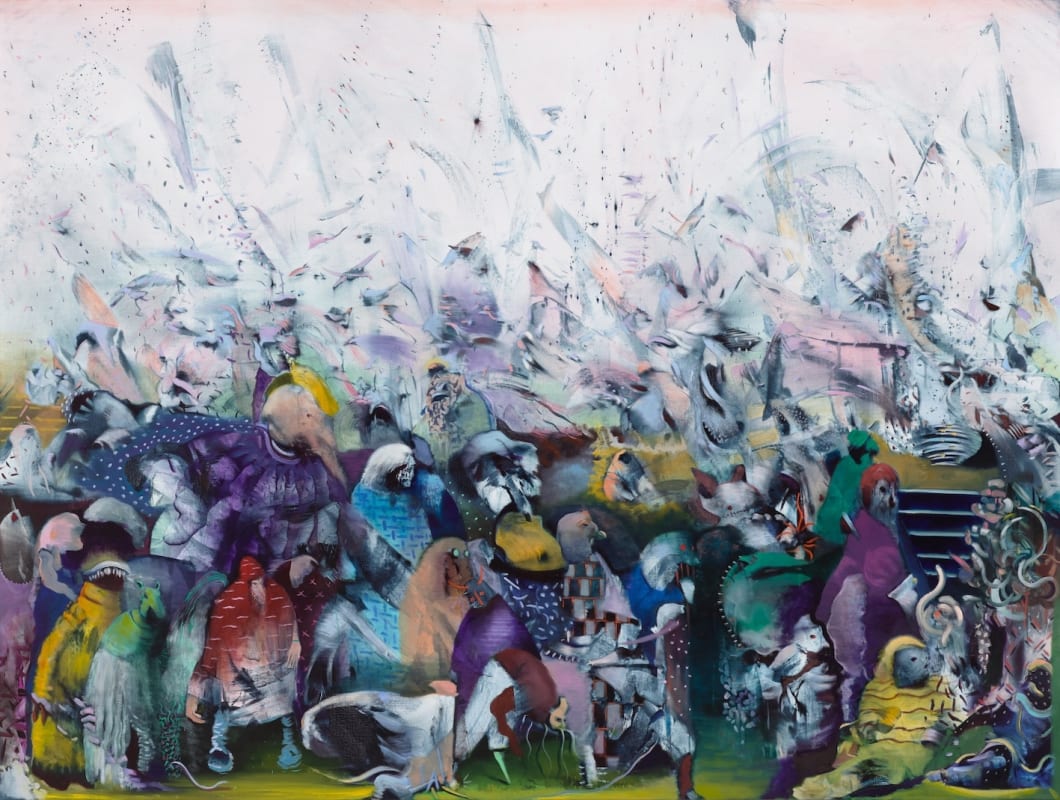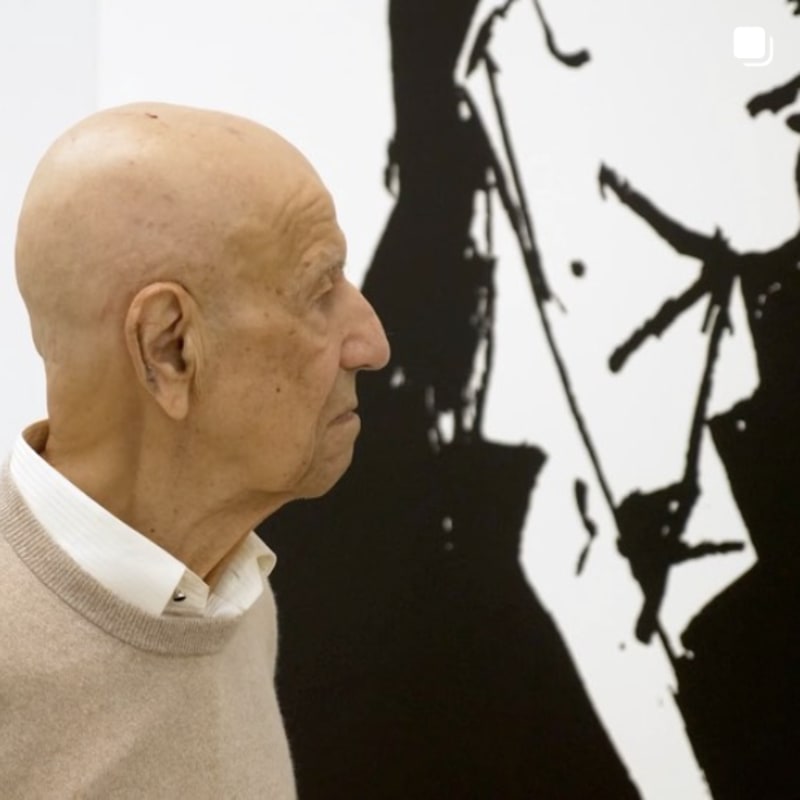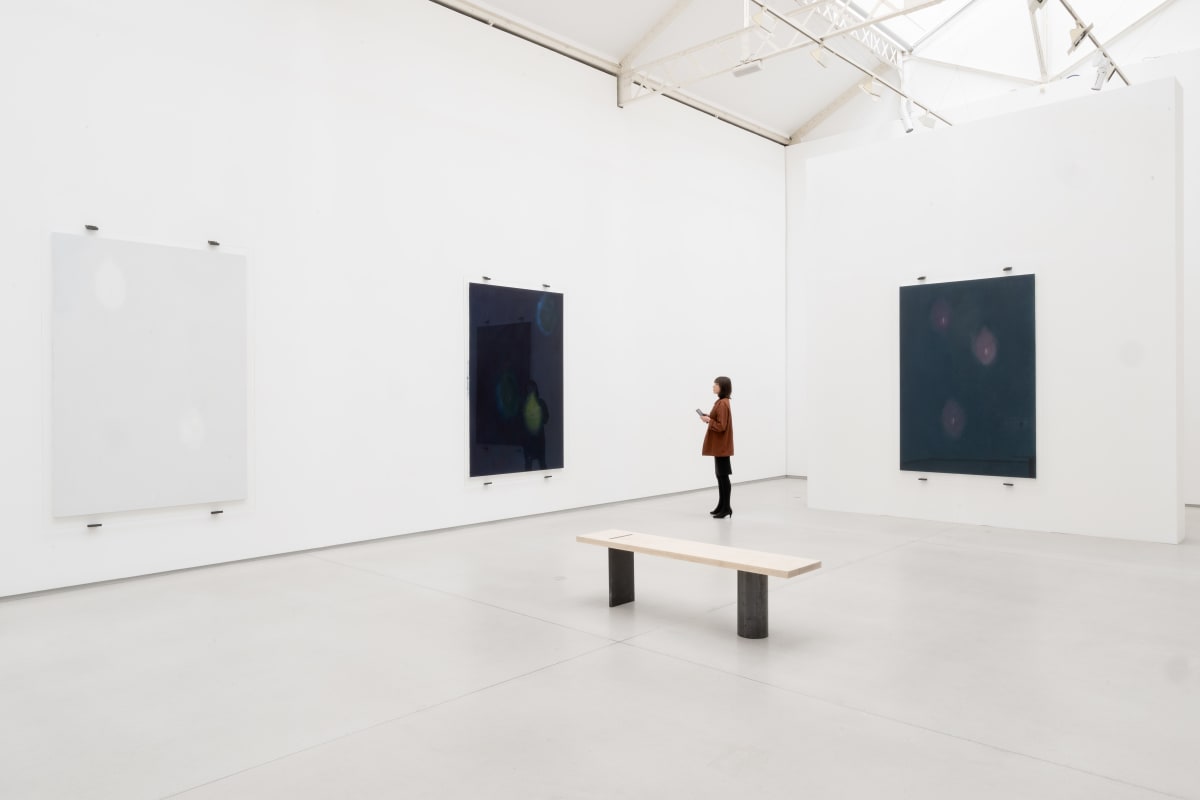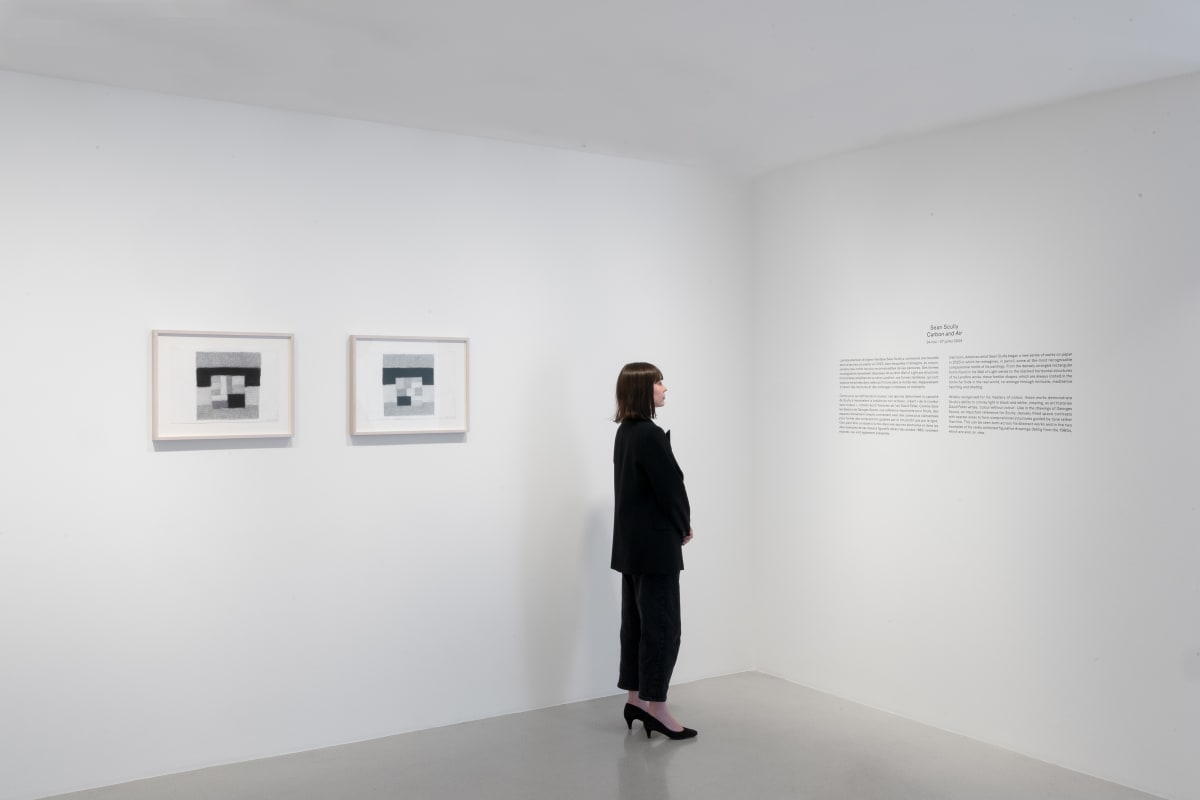Finding Hope in the Chaos: Ali Banisadr Interviewed by Osman Can Yerebakan
Paintings that blend and blur the world together.
When Brooklyn-based painter Ali Banisadr visited the Benaki Museum in Greece last year, he came across a blue-and-white Ming Dynasty-era vase in its collection. Much to the Iranian-born artist's surprise, a closer inspection revealed that his favorite poem by Persian poet Attar of Nishapur was inscribed on its surface. Besides being the artist's Instagram handle, Simorgh is the protagonist in Attar's circa 1177 poem, The Conference of the Birds, about thirty birds in search of the legendary namesake bird "with all the answers." When the flock reaches where they believe Simorgh resides, the poem climaxes with an epiphany: they, in fact, together make up the bird of the birds. "I've always loved the metaphor of thirty birds going on a journey together to learn that they are the very answer they were in search of," says Banisadr.
Banisadr's paintings are oftentimes large-scale panoramas of life-of yesterday, today, and the future. They look hauntingly erratic, yet they contain warm hues as soothers. There is exile, excess, greed, hunger along with pockets of hope, color, and jubilance. Figures blend into their surroundings, and environments create masses; his tones are bold, and occasionally splashy, with skies and lands coalescing through his arm- or wrist-length brushstrokes. Chaos prevails, but hope echoes overall. As someone who fled the Iranian Revolution at an early age, Banisadr is no stranger to tumult; however, he, too, admits that this past year prompted him to make discoveries over the canvas.
-Osman Can Yerebakan
Osman Can Yerebakan
Let's start with the Ming Dynasty-era vase. What was so intriguing about this discovery for you as a painter?
Ali Banisadr
The Attar poem has always been a part of me: I made a painting in 2018 titled Language of the Birds, which was also blue and white. When I talked to the Benaki Museum director, he said the vase was in cobalt blue which China at the time imported from the region of Iran and Iraq. I am intrigued by this intertwined journey between Europe where they commissioned these vases, China where they made them, and the Middle East where they sourced the paint. Moreover, they were heavily collected by the Dutch and Iranians, and, now, they're exhibited in Greece. I could see this as an alternative Silk Road running through geographies, from Asia toward Europe through the Middle East. From there, I see a link to my paintings which, in my opinion, slip out of visual, geographical, and historical categorizations, especially in the world today where we live somewhere between the digital and the analog.
The exhibition in Greece is titled Ultramarinus, and in Latin ultra is beyond and marine is blue, which can also mean sea. Back then in Europe, they had to go beyond the Mediterranean to source this blue color, so it was a highly regarded, sparse dye that was typically used for depictions of the Virgin Mary. Also keep in mind that the show opened on November 3, and the first painting greeting visitors is called Hypocrisy of Democracy (2012).
OCY
What does it mean to make paintings today when we are stuck between URL and IRL?
AB
I ask this to myself all the time, and painting saves me! I'm able to tap into a place above thinking, a place of intelligence that can only be accessed through painting. I haven't witnessed this other type of consciousness conveyed by any other medium in such a spiritual way. There's a mystical aspect to painting in which it creates a portal to a place smarter than what I could possibly reach. Every time I tried other mediums, I felt limited-they didn't mesh with my nature. Painting takes me back to an ancient way of thinking when people understood what they imagined through painting. It was basically magic that drove them to paint. They didn't do it to show in an exhibition or to sell. When I look at paintings from five hundred years ago from Northern Europe, I am able to communicate, and that is pretty powerful. The only other experience where I can see this possibility is in poetry.
OCY
How do you see poetry being experienced in Iranian culture which is predominantly lived indoors as opposed to Western culture where life is more outward?
AB
I could think back to my upbringing in Iran where culture revolves so much around visiting other families. And when you go to someone's place, it's not a two-hour visit-you're there the whole day. There are long conversations and books are always brought up. With my folks, we somehow always ended up at my uncle's library and started opening books. All of this in a way affected the core of my being.
OCY
A passage between past and present runs through your paintings, almost in a Proustian way. Timelessness is dressed with contemporary accents. For example, political turmoil or migration are topics relevant now as much as they were centuries ago.
AB
Think about the pandemic right now. When it first hit, I started to research its history and read about the Black Death and the Spanish Flu. I looked at paintings and read novels created in response to them. As much as research speaks to my brain, when I paint, I don't use any references. The painting itself ends up telling me about all those references, and I just have to digest them. In a way, I become the servant of the painting: I've accumulated information that I'm interested in, and this information somehow finds its abstract ways into the work.
OCY
Your figures are forward-facing, always in a processional and transient gesture. This could be the passage of time, cycle of order, or sign of change. If paintings are chronicles of their time, what do you think about leaving paintings for the fu
ture?
AB
One of the paintings in the Benaki show is Rise of the Blond from 2016, with a blond figure in a purple robe. He's entering the canvas with his entourage while another group is exiting the scene. Next to it is one of the two newest paintings in the show, titled SOS, from 2020. I almost called this painting "fall of the blond," but I figured it would have been too obvious. The painting came out of anxiety over the systems-political, racial, social, and financial-when everything peaked over the summer and we didn't have a clear picture. There is another painting I made for the Wadsworth exhibition this summer, The Healers, in which the predominant color is a fiery orange, almost a fire. I wanted to create an underworld, an inferno, where heat exists because of the anxieties. Two months after I finished the painting, my family in Northern California started to send me pictures of the forest fires where the scorching color was the same.
OCY
How was making new paintings during the pandemic?
AB
The Wadsworth show has a painting titled Red, which I finished in January, and the plan was to unveil it at Art Basel Hong Kong. The painting initially communicated with me from a place of anxiety that I did not want to move toward; instead, it wanted to be heavily red. I'm quite sensitive to colors, which can get inside of me and make me feel a certain way. The red occupying the canvas started to make me feel anxious, and I felt a danger in not knowing why.
Another one is a small painting, titled Only Breath, which came out quite urgently during the summer when helicopter noises had become a norm. That intense energy reminded me of my childhood in Iran during the war-fueled uncertainty. Fireworks recalled the sounds of explosion and bombing. The idea of breath first came in with the protesters who were using their breaths to express their voices; however, this later expanded to the virus that transmits through breath and even George Floyd whose killing happened through taking away his breath. Only Breath is also the title of one my favorite Rumi poems in which he talks about not wanting to be categorized or contained in any way.
OCY
How about the ongoing rise of pixilated abstraction against the waning of visual reality? We see people through screens, which have glitches inside and dust on the outside. How does Zoom reality affect your approach to painting?
AB
I find our generation fascinating because the initial half of our lives started out analog and we slowly transitioned to the digital. We are the witnesses who experienced both at great lengths. My understanding of abstraction and figuration now comes out of this duality. They both echo in whatever world we feel to be a part of at that moment. There is a rhizomatic idea in which roots and centers can go from one portal to another. A friend compared this to having multiple tabs open on the computer, and each one takes us to a different world. I see my paintings have that potential to serve as time machines which, in a way, the internet also is. I've always been interested in creating not a landscape but a worldscape, some kind of a new stage where the world is seen in the way we see it: blurred and blended together.
OCY
What if chaos left the universe and everything was pleasant around us. What would you paint?
AB
Let me refer to a section from Italo Calvino's Invisible Cities. In the conversation between Kublai Khan and Marco Polo, one of them talks about two ways to flee suffering. The first is easy, they say, because for many people the inferno becomes such a part of life that they can no longer see it. The second is risky and demands constant vigilance, apprehension, and learning to recognize that in the midst of the inferno is not inferno. I'd like to find those parts that could lead us to a better place. I have those areas within the painting where I could find hope through chaos. Within the chaos, there are elements of hope. In one painting, for example, there is a ladder leading upward. There is transformation and freedom there. The Healers can be considered hopeful and optimistic; there are figures with tentacles cleansing the earth of bad energy. The air is showered and cleaned.
Ali Banisadr: Ultramarinus is on view at the Benaki Museum in Athens, Greece, through February 21; MATRIX 185 is on view at the Wadsworth Atheneum Museum of Art in Hartford through February 14.
Osman Can Yerebakan is a curator and art writer based in New York. His writing has appeared in T: The New York Times Style Magazine, Paris Review, The Guardian, Artforum, Artnet, Brooklyn Rail, BOMB, Observer, New York Magazine, Wallpaper*, Village Voice, and elsewhere.















































































































































































